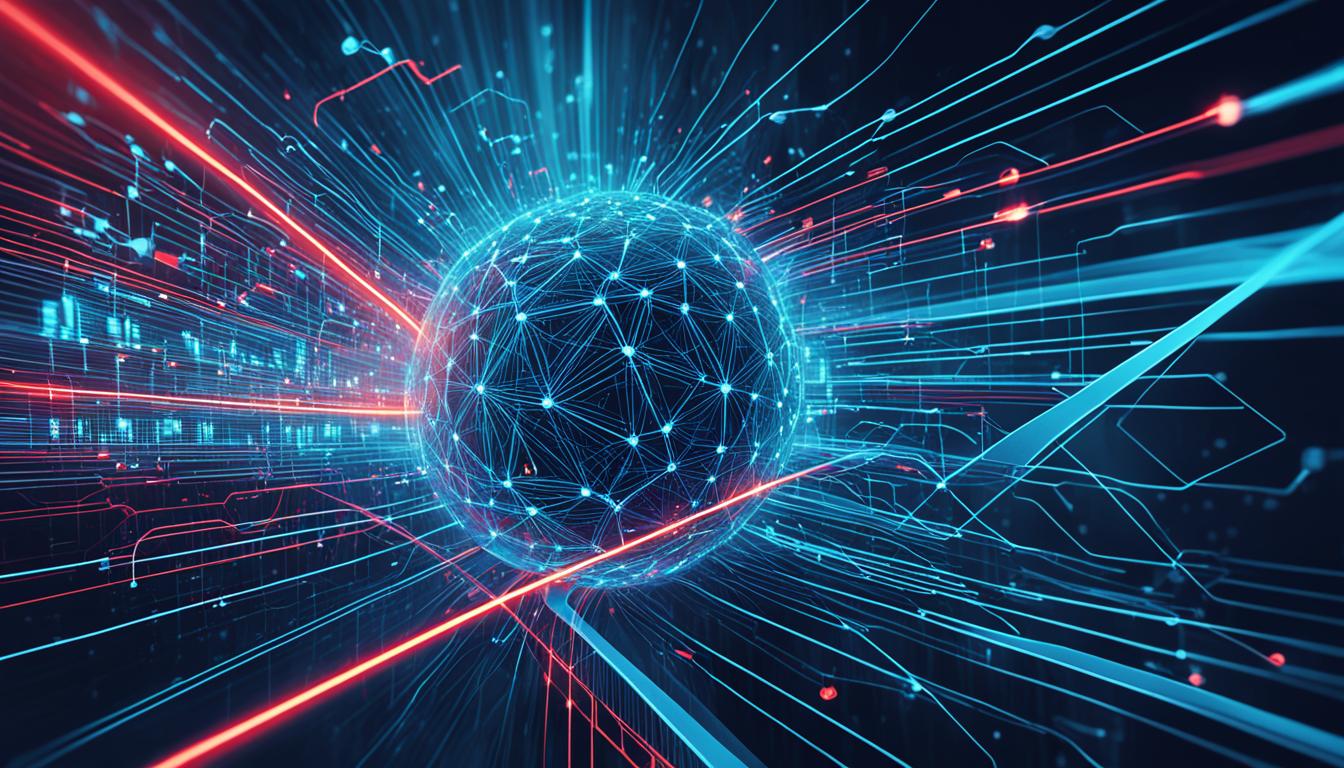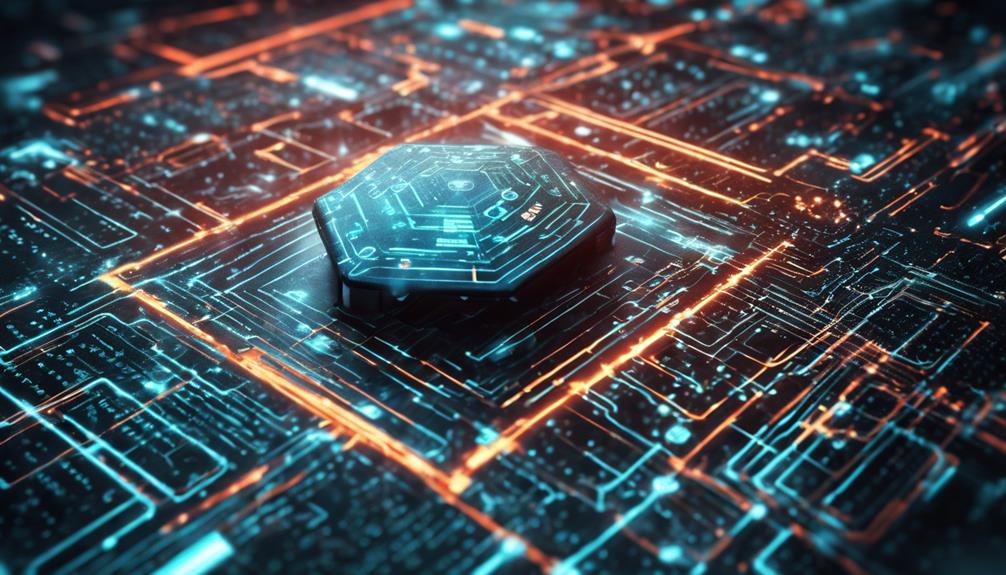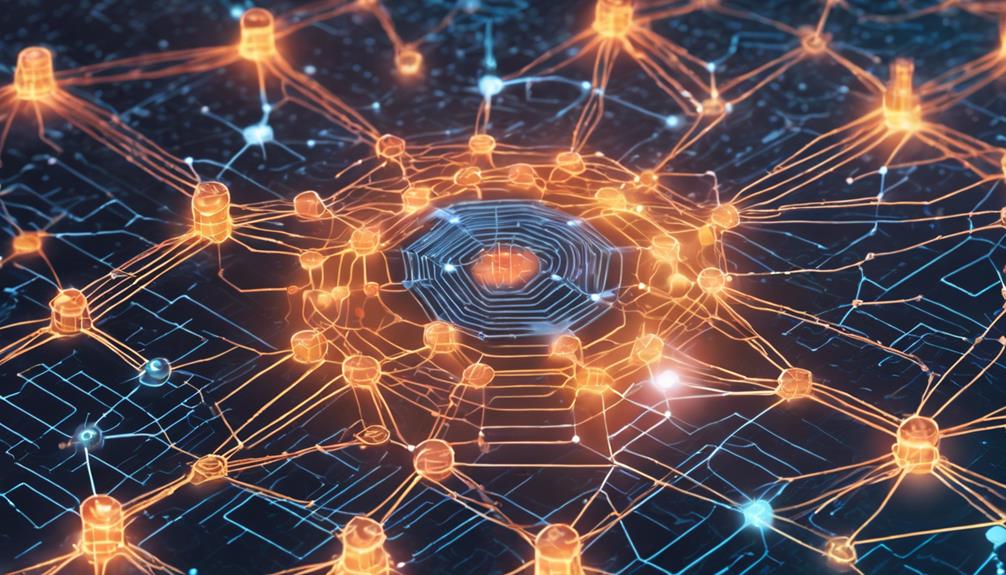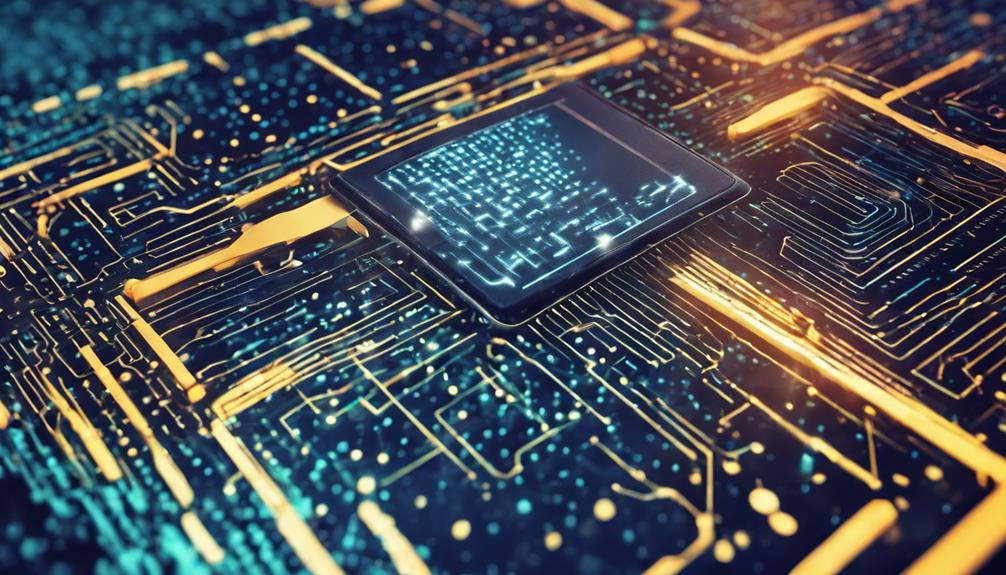Did you know that in 2024, blockchain technology is recognized for its revolutionary impact on data security across multiple industries1? Blockchain, commonly associated with cryptocurrencies, offers decentralized and secure data storage and transmission through cryptographic techniques and decentralized networks1. This groundbreaking technology is transforming the landscape of data security by providing immutable records, decentralized data storage, cryptographic security, smart contracts, and consensus mechanisms1.
Blockchain technology operates on a distributed, public, and permissionless network framework2. Each block of data on a blockchain is cryptographically linked to its predecessor, creating an unbreakable chain2. This ensures that alterations or deletions of data without network consensus are nearly impossible2. The use of cryptographic hash functions guarantees that even minor changes in data will result in a completely different hash2. With its decentralized nature, blockchain eliminates single points of failure, making it challenging for attackers to gain control over the entire dataset2. Moreover, blockchain technology streamlines compliance with current regulations and enhances an organization’s overall cybersecurity readiness2.
Educating individuals about blockchain technology is crucial to broaden understanding and acceptance beyond cryptocurrencies2. Blockchain ensures data protection, trust, and integrity in the digital era2. In healthcare, blockchain secures patient records, reducing the risk of data breaches and ensuring data integrity1. In finance, blockchain facilitates secure and transparent transactions, preventing fraud and enhancing financial data integrity1. In supply chain management, blockchain enhances transparency and traceability, reducing the risk of counterfeiting1. In government, blockchain ensures the integrity and transparency of voting systems, enhancing security in electoral processes1. In real estate, blockchain secures property records, simplifying property ownership transfers and reducing fraud1.
While blockchain technology presents immense potential, it also faces challenges such as scalability, regulatory uncertainty, and the need for system and process changes for widespread adoption1. However, the future prospects for blockchain technology include quantum-resistant cryptography and improved consensus mechanisms, promising enhanced security and efficiency for blockchain networks1.
Key Takeaways:
- Blockchain technology revolutionizes data security across various industries1.
- It offers decentralized and secure data storage and transmission through cryptographic techniques1.
- Blockchain provides immutable records, decentralized data storage, cryptographic security, smart contracts, and consensus mechanisms1.
- In healthcare, finance, supply chain management, government, and real estate, blockchain enhances data security and integrity1.
- Challenges include scalability, regulatory uncertainty, and the need for system and process changes1.
- Future prospects include quantum-resistant cryptography and improved consensus mechanisms1.
Understanding Blockchain
Blockchain, a decentralized ledger technology, is revolutionizing data security across various industries1. Unlike traditional centralized systems, blockchain securely records transactions across multiple computers, ensuring transparency, decentralization, and immutability1. These principles make blockchain a powerful tool for enhancing data security and integrity1. Transactions recorded on the blockchain cannot be altered or deleted, guaranteeing data integrity1.
Imagine a digital ledger that is distributed across multiple computers, also known as nodes. Each transaction is bundled into a block and cryptographically linked to the previous block, creating an immutable chain of data2. This cryptographic linking adds an extra layer of security, making it virtually impossible for anyone to alter past transactions without detection2.
Blockchain’s decentralized nature and consensus mechanism further enhance data security. The distributed network of nodes eliminates single points of failure, making it resistant to attacks and ensuring data resilience1. Moreover, verifying and sealing transactions through consensus mechanisms prevent fraudulent activities like double-spending or tampering with financial records2.
Blockchain technology also utilizes cryptographic hash functions to transform data into unique hash values, ensuring the integrity and authenticity of the data2. These hash values act as digital fingerprints, making it nearly impossible to alter or tamper with the underlying data without being detected2.
By adopting blockchain, organizations can streamline compliance with regulations and strengthen their overall cybersecurity readiness2. Blockchain’s transparent and auditable nature provides benefits not only in the context of cryptocurrencies but also across various sectors like healthcare, finance, supply chain management, government, and real estate1. However, there are still challenges to overcome, such as scalability, regulation, and adoption hurdles1. The future of blockchain technology holds promising innovations like quantum-resistant cryptography and improved consensus mechanisms, which will further enhance its security and efficiency12.
| Benefits of Blockchain for Data Security | Statistical Data References |
|---|---|
| Transparency | 1 |
| Decentralization | 1 |
| Immutability | 1 |
| Data Integrity | 12 |
| Distributed Network | 12 |
| Advanced Cryptography | 12 |
| Smart Contracts | 1 |
| Consensus Mechanisms | 12 |
Blockchain in Various Industries
- In Healthcare: Blockchain can secure patient records, protect sensitive data, and streamline interoperability between healthcare providers1.
- In Finance: Blockchain enables secure and transparent transactions, simplifies auditing, and reduces the risk of fraud1.
- In Supply Chain Management: Blockchain enhances transparency, traceability, and reduces the risk of counterfeiting and fraud in the supply chain1.
- In Government: Blockchain can be used to create tamper-proof voting systems, ensuring the integrity of elections and reducing voter fraud1.
- In Real Estate: Blockchain secures property records, simplifies property ownership transfer, reduces fraud, and enhances transparency in real estate transactions1.
Enhancing Data Security with Blockchain
Blockchain technology offers a robust solution for enhancing data security, leveraging features such as immutable records, decentralized data storage, and cryptographic security.
Immutable Records
One of the key advantages of blockchain technology is its ability to provide immutable records, protecting data from manipulation and fraud. The blockchain ensures that once data is recorded, it cannot be changed or deleted, maintaining the integrity of information1.
Decentralized Data Storage
Decentralized data storage is another significant feature of blockchain technology, reducing the vulnerability of data to attacks and breaches. With decentralized storage, data is distributed across a network of nodes, eliminating single points of failure and making it difficult for hackers to compromise the entire dataset1.
Cryptographic Security
Cryptographic security is a fundamental element of blockchain. It ensures that data can only be accessed and interpreted by authorized parties through the use of encryption techniques. This layer of cryptographic security enhances the confidentiality and privacy of data1.
By leveraging these features, blockchain technology offers a more secure and resilient approach to data storage and transmission, making it a compelling solution for industries seeking to fortify their data security defenses.
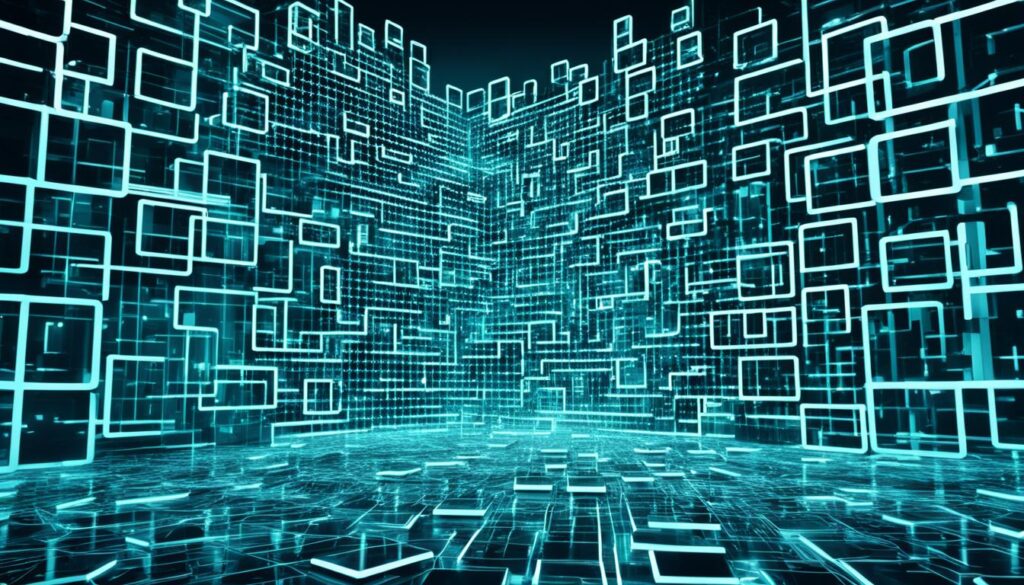
Smart Contracts
Smart contracts are self-executing contracts with predefined rules and conditions directly written in code1. These contracts automate and enforce agreements, reducing the need for intermediaries and enhancing security1. By eliminating the reliance on third parties, smart contracts streamline processes and provide a more efficient and secure way of executing agreements. They ensure that all parties involved adhere to the predefined rules and conditions set forth in the contract, minimizing the risk of disputes or breaches of contract. With smart contracts, transactions can be automatically executed once specific conditions are met, improving the efficiency and reliability of contractual processes.
One of the key advantages of smart contracts is their ability to eliminate the need for intermediaries1. Traditional contract execution often involves intermediaries such as lawyers or brokers to ensure compliance and resolve disputes. However, smart contracts remove this reliance by automating the execution based on predefined conditions, reducing costs and improving efficiency. This increased automation can also enhance security by reducing the potential for human error or manipulation.
Furthermore, smart contracts provide increased transparency and accountability in agreements1. All the rules and conditions of the contract are written directly into the code, making it easy to verify and track the execution of the contract. This transparency helps to build trust among parties involved, as they can have full visibility into the execution and outcomes of the contract. Additionally, the immutability of blockchain ensures that once a smart contract is executed, it cannot be altered or tampered with, further enhancing the integrity and reliability of the agreement.
Benefits of Smart Contracts:
Smart contracts offer several benefits in various industries. Here are some key advantages:
- Efficiency: Smart contracts automate and streamline contract execution processes, reducing manual efforts and saving time for all parties involved.
- Cost savings: By eliminating the need for intermediaries and automating processes, smart contracts can significantly reduce costs associated with contract execution and compliance.
- Immutability: Once a smart contract is executed, it becomes part of the blockchain and cannot be altered or tampered with, ensuring the integrity and reliability of the agreement.
- Transparency: The rules and conditions of a smart contract are publicly available on the blockchain, providing transparency and accountability in the execution of agreements.
- Security: Smart contracts utilize cryptographic security measures and the decentralized nature of blockchain to ensure that only authorized parties can access and interpret the contract.
- Efficient dispute resolution: Smart contracts can have predefined mechanisms for dispute resolution, making it easier to resolve conflicts or breaches of contract without the need for lengthy legal processes.
Overall, smart contracts revolutionize the way agreements are executed by providing a more efficient, secure, and transparent method. They have the potential to transform various industries by simplifying contract processes, reducing costs, and enhancing trust among parties involved.
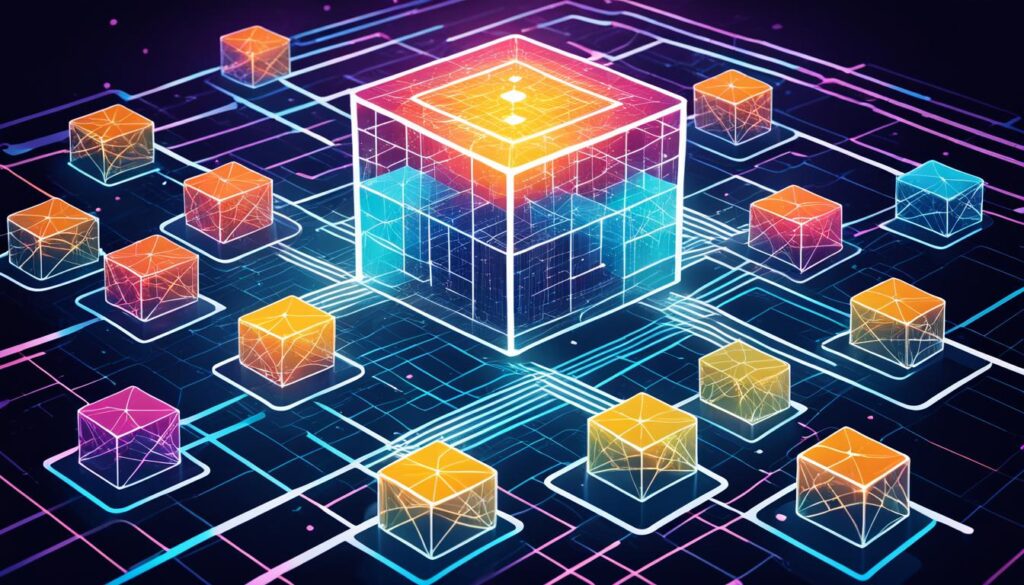
Consensus Mechanisms
One of the key elements that make blockchain technology secure and reliable is its consensus mechanisms. In the blockchain network, transactions are verified through a collective agreement process among network participants1. This consensus mechanism ensures the accuracy and validity of transactions by requiring network participants to agree on the validity of each transaction before it is added to the blockchain1.
By involving multiple participants in the transaction verification process, blockchain significantly reduces the likelihood of fraudulent transactions. Malicious actors would need to compromise a majority of the network to manipulate the blockchain, making it highly resistant to fraud and tampering1. This collective agreement process enhances the security and integrity of the blockchain network, providing a trusted environment for transactions and data storage1.
Consensus mechanisms in blockchain can vary depending on the specific blockchain network. Popular consensus mechanisms include Proof of Work (PoW), Proof of Stake (PoS), and Delegated Proof of Stake (DPoS). These mechanisms ensure the validation of transactions and maintain the integrity of the network3.
Through the consensus mechanisms, blockchain technology has been successfully applied in various industries. In supply chain management, for example, blockchain ensures transparency and trust among stakeholders by verifying and recording each transaction in a tamper-proof manner3. This enhances accountability and reduces the risks of counterfeiting and fraud in supply chains3.
In conclusion, consensus mechanisms play a vital role in the security and reliability of blockchain technology. They enable collective transaction verification and agreement processes, reducing the risk of fraudulent activities. With blockchain’s decentralized and consensus-driven approach, data integrity and security are significantly enhanced, making it a valuable technology for various industry sectors.
Applications of Blockchain in Data Security
Blockchain technology has diverse applications in data security across various industries, including healthcare, finance, supply chain management, government, and real estate. By leveraging the cryptographic security and decentralized nature of blockchain, these industries can enhance data protection, transparency, and integrity.
Healthcare
In healthcare, blockchain ensures the secure and immutable storage of patient records. By recording medical data on a blockchain, healthcare providers can reduce the risk of data breaches and fraud. The permanent and tamper-proof nature of blockchain data1 provides trust and security1 for confidential patient information.
Finance
Blockchain technology presents a secure and transparent way to record financial transactions. By leveraging blockchain, the finance industry can prevent fraud and improve data integrity. The decentralized and tamper-proof nature of blockchain ensures the legitimacy of transactions, making it difficult for malicious actors to manipulate financial records1.
Supply Chain Management
Blockchain enhances transparency and traceability in supply chain management. By recording every transaction in a blockchain, companies can ensure the authenticity and integrity of their goods. This reduces the risk of counterfeiting and improves the overall supply chain1.
Government
Blockchain technology has the potential to revolutionize government processes, particularly in creating tamper-proof voting systems. By utilizing blockchain, governments can ensure the integrity and transparency of elections. The decentralized nature of blockchain makes it nearly impossible to manipulate or tamper with voting records1.
Real Estate
In the real estate industry, blockchain technology secures property records and simplifies property ownership transfers. By implementing blockchain, the industry can reduce fraud and disputes over property ownership. The permanent and transparent nature of blockchain records ensures the authenticity and reliability of property transactions1.

Overcoming Challenges
Despite the numerous benefits of blockchain technology, it faces various challenges that need to be addressed for widespread adoption and scalability.
- Scalability: One of the primary challenges facing blockchain technology is scalability. As the number of transactions on a blockchain network increases, the system can become slower and less efficient. This scalability issue needs to be resolved to enable blockchain to handle large-scale applications and accommodate the growing demand for data processing. Nonetheless, efforts are underway to develop solutions such as sharding, sidechains, and layer 2 protocols to enhance blockchain scalability1.
- Regulatory Uncertainty: Another challenge hindering blockchain adoption is regulatory uncertainty. The evolving nature of blockchain technology raises questions regarding legal and regulatory frameworks. Different jurisdictions have varying approaches to blockchain regulation, which can create ambiguity and deter businesses from fully embracing blockchain solutions. Governments and regulatory bodies need to establish clear and comprehensive guidelines to ensure the legal certainty and compliance of blockchain applications1.
- Adoption: The adoption of blockchain technology requires significant changes in existing systems and processes. Integrating blockchain into legacy systems can be complex and costly. Moreover, organizations need to educate their employees about blockchain technology and its potential benefits. Overcoming the resistance to change and fostering a culture of blockchain adoption are crucial steps towards realizing the full potential of this technology1.
Addressing these challenges is vital to unlocking the true potential of blockchain technology and leveraging its benefits in various sectors, including healthcare, finance, supply chain management, government, and real estate1. Stakeholders across industries must collaborate and invest in research and development to overcome these obstacles and create an environment conducive to the widespread adoption of blockchain.

Future Prospects
The future of blockchain technology holds great promise in revolutionizing data security and privacy. To further enhance the security and efficiency of blockchain networks, there are two key areas of development: quantum-resistant cryptography and improved consensus mechanisms.
Quantum-resistant cryptography is an emerging field that aims to safeguard encrypted data from future quantum-based attacks. As quantum computers become more powerful, traditional cryptographic algorithms could be vulnerable to decryption. By implementing quantum-resistant cryptography, blockchain networks can ensure the long-term security of sensitive data, protecting it from potential quantum threats1.
Improved consensus mechanisms are another focus for enhancing blockchain security and efficiency. Consensus mechanisms play a crucial role in validating and confirming transactions on the blockchain. Innovations such as Proof of Stake (PoS) and Byzantine Fault Tolerance (BFT) offer more energy-efficient and secure consensus protocols compared to traditional Proof of Work (PoW) algorithms. These improved consensus mechanisms not only enhance the integrity and accuracy of blockchain networks but also reduce the environmental impact associated with energy-intensive mining operations1.
With the integration of quantum-resistant cryptography and improved consensus mechanisms, blockchain technology will be better equipped to address the evolving challenges in data security and privacy. As industries continue to harness the power of blockchain, these advancements will further solidify its position as a transformative tool for secure and efficient data management1.
Data Integrity and Provenance
Ensuring data integrity and provenance is crucial in supply chain management. Blockchain technology, with its transparent and tamper-proof log of transactions, addresses these concerns effectively and mitigates the risk of counterfeit products and fraud.
By leveraging blockchain, companies can create a trustworthy and transparent supply chain ecosystem. Each transaction recorded on the blockchain is securely time-stamped, cryptographically signed, and immutable, establishing a foundation of data integrity and provenance4. This real-time verification process significantly reduces fraud and counterfeiting, allowing businesses to maintain the authenticity and quality of their products.
Additionally, blockchain-based platforms enable transparent and automated royalty payments in supply chains4. By utilizing smart contracts, which are self-executing contracts with predefined rules and conditions, companies can ensure fair compensation throughout the supply chain process, fostering trust and enhancing collaboration.
Furthermore, blockchain technology provides a transparent and tamper-proof record of transactions, making it easier to identify and prevent the entry of counterfeit or substandard products into the market5. This brings greater confidence to consumers, reduces the risk of harm, and safeguards brand reputation.

| Benefits of Blockchain in Supply Chain Management | Statistical Data Reference |
|---|---|
| Real-time visibility and traceability of products | 5 |
| Reduction in fraud and counterfeiting | 4 |
| Secure and transparent payment processing | 4 |
| Improved supply chain efficiency and collaboration | 5 |
Blockchain technology’s impact on supply chain management is transformative, providing enhanced transparency and accountability. By implementing blockchain-based solutions, businesses can protect their supply chains, maintain data integrity, and ensure the authenticity of their products.
Identity and Access Management
Identity and access management play a critical role in today’s digital landscape, where protecting personal information has become increasingly crucial. Blockchain technology offers innovative solutions, such as self-sovereign identity and decentralized identity networks, that enhance security and control over digital identities.
With self-sovereign identity, individuals have complete ownership and agency over their personal data and digital identities. They can manage and authenticate their identities without relying on centralized authorities or intermediaries, reducing the risk of identity theft and unauthorized access6.
Decentralized identity networks, built on blockchain technology, provide a secure and transparent environment for identity verification and authentication. They leverage cryptographic techniques to ensure the integrity and confidentiality of personal information6. By utilizing the distributed and immutable nature of the blockchain, these networks minimize the risk of data breaches and manipulation, giving individuals greater control over their digital identities.
“Blockchain-based identity solutions have the potential to revolutionize how we manage and protect personal information, offering enhanced security, privacy, and user control.” Source: First source
One of the significant advantages of blockchain-based identity solutions is inclusivity. These solutions can provide digital identities to individuals who lack official documentation or formal identification6. This broader inclusion enables marginalized communities to access essential services, such as healthcare, finance, and education, which may have previously been unavailable to them7.
Blockchain technology also streamlines verification processes, reducing administrative overhead and enhancing efficiency. Through decentralized networks, identity verification can occur quickly and securely, facilitating faster access to services and reducing bureaucratic hurdles6.
Another benefit of blockchain-based identity management is the potential for interoperability and standardization. Different identity systems can be integrated and connected, allowing for seamless sharing and verification of digital identities across various platforms and organizations6. This promotes convenience and simplifies the authentication process for both individuals and service providers.
While blockchain offers significant advantages for identity and access management, implementing blockchain-based solutions does come with challenges. Scalability remains a significant concern, as blockchain networks need to handle a massive volume of identity-related transactions while maintaining efficiency and speed6. Regulatory compliance is another important consideration, as identity management involves sensitive personal information that must adhere to data protection and privacy regulations6. Additionally, user adoption and acceptance are crucial for the success of blockchain-based identity solutions, requiring education and awareness to promote trust and confidence among users6.
Real-world applications of blockchain-based identity solutions are already emerging. Projects like Sovrin, uPort, and Estonia’s e-Residency program showcase the potential and viability of blockchain technology for identity and access management6. These initiatives leverage blockchain to create secure, verifiable, and user-centric digital identities, enhancing security and privacy in various sectors.
| Statistical Data | Reference |
|---|---|
| Over 7.9 billion data records were exposed in the first nine months of 2019. | 8 |
| The average cost of a data breach was estimated to be $3.86 million. | 8 |
| Identity theft cases in the U.S. increased by 20% in 2020. | 8 |
| Phishing attacks have grown by 30% year-over-year. | 8 |
Secure Communication and File Sharing
Decentralized cloud storage and secure file sharing are critical aspects of maintaining data security in a digital landscape. With the rise of cyber threats and the need for privacy, blockchain technology offers a secure and decentralized platform to address these concerns.
Construction projects involve multiple stakeholders, including workers, clients, contractors, and regulatory bodies, making data security a top priority9. Protecting personal information, such as names, addresses, and qualifications, is essential in preventing identity theft and potential harm9. Furthermore, the shortage of skilled labor in the construction industry emphasizes the importance of safeguarding workers’ personal data to attract and retain talent9.
Moreover, in the construction industry, safety-related data on workers is vital due to the industry’s job-related risks and physically strenuous tasks, which can lead to non-lethal injuries9. Additionally, musculoskeletal disorders (WMSDs) resulting from repetitive movements and awkward postures impact workers’ health9.
Traditional data management methods in construction, such as centralized databases, are vulnerable to breaches and unauthorized data manipulation, jeopardizing project credibility and worker safety9. Thus, innovative solutions are necessary to ensure data security and privacy within the construction industry and beyond.
Blockchain technology offers a secure way to manage construction workers’ personal and safety data, maintaining privacy through permissioned access9. By leveraging blockchain’s principles of immutability and transparency, sensitive data in construction can be securely stored, preventing unauthorized alterations and fostering trust among stakeholders9.
Furthermore, data stored on the blockchain is encrypted and accessible only to authorized parties with the corresponding cryptographic keys, reducing the risk of unauthorized access and data breaches10. The transparency of the blockchain also facilitates easy auditing of transactions, enhancing accountability and transparency in data sharing10.
Blockchain technology’s benefits extend beyond the construction industry, offering secure communication and file sharing in various sectors such as finance, healthcare, government, energy, and supply chain management10. Decentralized cloud storage platforms like Storj and Sia leverage blockchain to provide secure and resilient storage and sharing of files9.

Internet of Things (IoT) Security
As the Internet of Things (IoT) continues to expand, ensuring the security of connected devices becomes paramount. Blockchain technology offers a decentralized and secure infrastructure for device authentication, data sharing, and access control, providing a robust solution to mitigate the risks associated with IoT security threats.11
Blockchain’s decentralized nature ensures secure communication and data exchange among IoT devices. By leveraging cryptographic techniques, blockchain verifies the authenticity of devices and users, preventing unauthorized access and data tampering. This decentralized approach eliminates the need for a centralized authority, reducing the vulnerability to single points of failure and potential cyber attacks.11
Furthermore, blockchain’s immutable ledger offers traceability and transparency, allowing for secure data sharing in the IoT ecosystem. Authorized participants can securely collaborate and share information, ensuring data integrity and authenticity throughout the network. This is particularly crucial in scenarios such as supply chain management, where validating the provenance and authenticity of goods is essential.11
Ensuring Device Authentication
Device authentication is a critical component of IoT security. Blockchain technology provides a decentralized mechanism for verifying and authenticating devices within the network. Through the use of cryptographic protocols, IoT devices can securely identify and authenticate each other, minimizing the risk of unauthorized access and compromised data.11
Secure Data Sharing
Data sharing among IoT devices and stakeholders is a fundamental aspect of IoT operations. Blockchain enables secure and trusted data sharing by creating an immutable and transparent record of transactions and interactions. Authorized users can access and share data while maintaining data integrity and confidentiality. This helps protect sensitive information and prevents unauthorized data access or tampering.11
Access Control and Permissions
Access control is crucial in an IoT environment to ensure that only authorized entities can interact with devices and access sensitive data. Blockchain’s decentralized architecture enables the implementation of fine-grained access control mechanisms. Smart contracts can be used to define and enforce access policies, ensuring that only authorized users or devices can perform specific actions or access certain resources within the IoT network.11
IoT Security Challenges
While blockchain technology offers significant enhancements to IoT security, several challenges still need to be addressed. Scaling blockchain networks to handle the massive number of IoT devices and their data transactions remains a technical challenge. Interoperability and standardization also pose barriers to widespread adoption, as different IoT devices and platforms may utilize incompatible protocols.11,12
Nevertheless, the promise of blockchain technology in enhancing IoT security has driven research and development efforts towards addressing these challenges. As industry standards evolve, and scalability solutions are implemented, blockchain will play a crucial role in securing the future of IoT and enabling secure and trustworthy interactions between devices, users, and data.11,12
| IoT Security Statistics and Predictions |
|---|
| The number of IoT-connected devices is projected to exceed 75 billion in the near future. |
| Gartner predicts that over 20% of businesses will deploy security solutions for protecting their IoT devices and services by 2017. |
| Blockchain technology ensures transparency as all participants can see the blocks and transactions stored, although the actual content is protected by private keys. |
| Adoption of a standardized peer-to-peer communication model in decentralized IoT networks can significantly reduce costs associated with centralized data centers. |
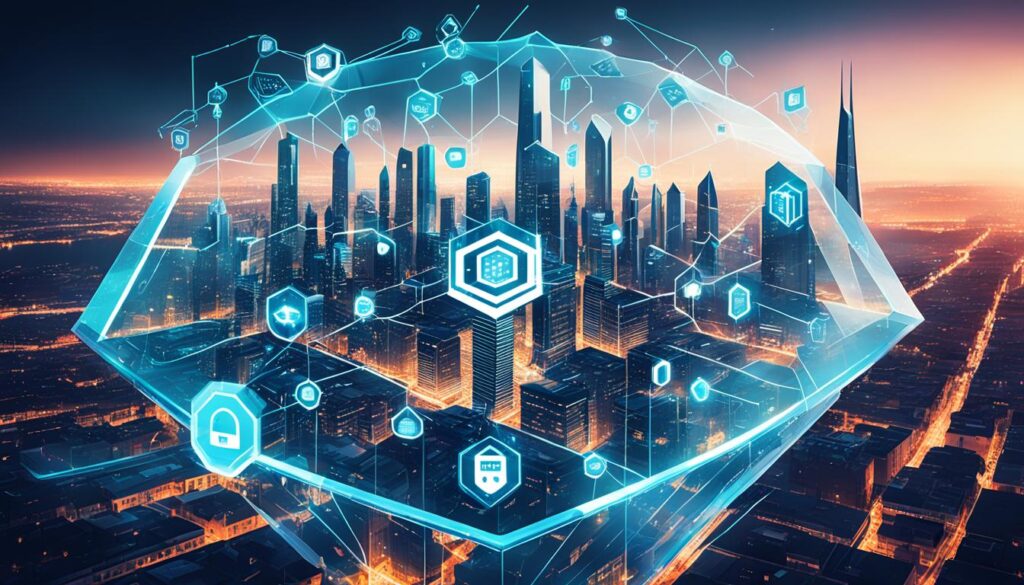
Secure Smart Contracts
Blockchain technology enables secure smart contracts that automate the execution of agreed-upon actions and enhance security in various applications (Source 2). Smart contracts, powered by blockchain platforms like Ethereum, eliminate the need for intermediaries and ensure automated execution of predefined rules (Source 2). With the decentralized nature of blockchain, smart contracts provide increased transparency and immutability, making them resistant to fraud and tampering (Source 2).
One of the key benefits of smart contracts is their ability to automate and enforce agreements, reducing human error and enhancing security through predefined rules (Source 1). By replacing traditional intermediaries, smart contracts streamline processes, eliminate the need for trust between parties, and provide a secure and efficient framework for executing transactions (Source 1, Source 2).
The decentralized nature of blockchain and smart contracts presents significant advantages in decentralized applications (DApps). DApps leverage smart contracts to create self-executing applications that run on a decentralized network, ensuring automated execution and enhancing security (Source 2). By utilizing secure smart contracts, DApps reduce the risk of unauthorized access, fraud, and manipulation, offering users a reliable and secure experience (Source 2, Source 3).
Within the realm of decentralized applications, secure smart contracts lay the foundation for a range of innovative solutions across industries, including finance, supply chain management, and more (Source 3). These contracts enable automated and trustless transactions, providing a high level of security while reducing dependency on intermediaries (Source 3).
The Role of Secure Smart Contracts in Decentralized Finance (DeFi)
In decentralized finance (DeFi), secure smart contracts power a wide range of financial applications such as lending, borrowing, decentralized exchanges, and yield farming (Source 3). These contracts ensure that transactions are executed automatically based on predefined rules, eliminating the need for centralized authorities and intermediaries in the financial ecosystem (Source 2).
Secure smart contracts in DeFi provide users with greater control over their assets and finances, as well as enhanced security through cryptographic mechanisms (Source 2). By eliminating the need to trust centralized intermediaries, secure smart contracts enable individuals to directly interact with decentralized financial protocols while maintaining ownership and control over their funds (Source 2). This eliminates the risk of funds being mismanaged or misappropriated by centralized entities (Source 2).
“Secure smart contracts in DeFi enable seamless and automated financial interactions, providing users with increased control over their funds and reducing reliance on traditional intermediaries.” 13
| Benefits of Secure Smart Contracts | Source |
|---|---|
| Automated execution of agreed-upon actions | Source 2 |
| Enhanced security through predefined rules | Source 1 |
| Reduction of human error | Source 1 |
| Elimination of intermediaries | Source 1, Source 2 |
| Increased transparency and immutability | Source 2 |
| Secure and reliable decentralized applications (DApps) | Source 2, Source 3 |
| Automation and trustless transactions | Source 3 |
| Enhanced control and security in decentralized finance (DeFi) | Source 2 |
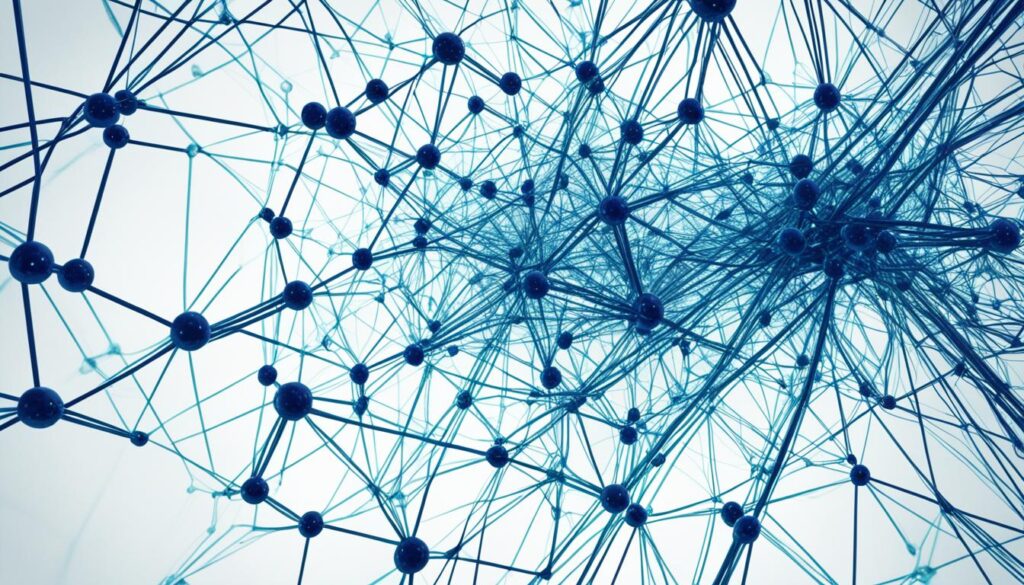
The power of secure smart contracts in blockchain technology lies in their ability to automate and enforce agreements, reducing the need for intermediaries and enhancing security across various applications. Whether powering decentralized finance or streamlining processes in other industries, secure smart contracts revolutionize the way transactions are executed, providing individuals with increased control and peace of mind (Source 1, Source 2, Source 3).
Challenges and Limitations of Blockchain in Cybersecurity
Blockchain technology has emerged as a game-changer in the field of cybersecurity, providing decentralized and secure solutions for data protection. However, its adoption and implementation are not without challenges. Three key challenges that need to be addressed are scalability, interoperability, and standardization.
Scalability
One of the primary concerns with blockchain technology is its scalability. As the number of transactions on a blockchain increases, the network can experience delays and congestion. This makes it crucial to find ways to scale the blockchain network to accommodate a larger volume of transactions without compromising its security and efficiency. Ensuring smooth and rapid transaction validation is essential for the widespread adoption of blockchain technology14.
Interoperability
Interoperability refers to the ability of different blockchain networks to communicate and interact with each other seamlessly. Currently, there are numerous blockchain platforms, each with its own set of protocols and standards. This lack of interoperability hinders the seamless exchange of data and assets between different blockchain networks. To realize the full potential of blockchain technology, establishing interoperability between various networks is important. It would allow for the efficient sharing of information and resources, promoting collaboration and innovation in the cybersecurity space14.
Standardization
Standardization is vital for the widespread adoption of blockchain technology in cybersecurity. The absence of universally accepted standards and best practices creates ambiguity and inhibits the development of a cohesive ecosystem. Establishing industry-wide standards would enable organizations to adopt and implement blockchain technology more confidently, ensuring compatibility, security, and interoperability among different systems and networks. Standardization will drive innovation and collaboration while mitigating potential risks and challenges14.
“To realize the full potential of blockchain technology, addressing scalability, interoperability, and standardization challenges is crucial.”
Challenges and Limitations of Blockchain in Cybersecurity
| Challenge | Description |
|---|---|
| Scalability | The need to handle a larger volume of transactions without delays or congestion. |
| Interoperability | The ability of different blockchain networks to communicate and share data seamlessly. |
| Standardization | The establishment of universally accepted standards and best practices for blockchain technology. |
Addressing the challenges of scalability, interoperability, and standardization will pave the way for the wider adoption of blockchain technology in cybersecurity. Overcoming these hurdles will contribute to the transformation of the cybersecurity landscape, enhancing data protection, privacy, and trust in the digital age.
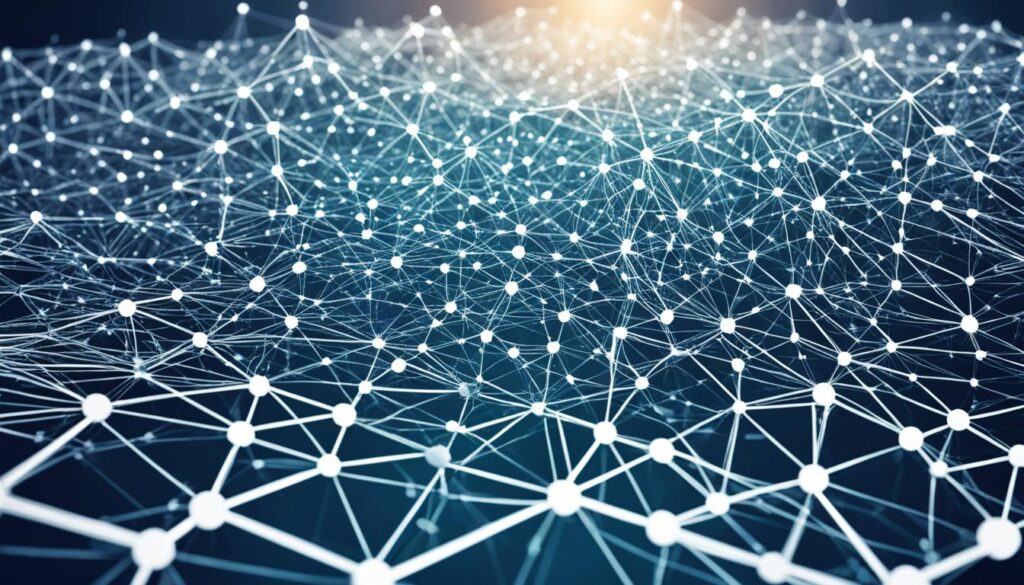
Education and Adoption
Educational efforts are vital in distinguishing blockchain technology from cryptocurrencies and highlighting its wider potential and innovation (Second source:15). As blockchain continues to gain recognition for its secure data storage and transmission capabilities, it is crucial to foster a clear understanding of its applications beyond the realm of cryptocurrencies.
By differentiating blockchain from cryptocurrencies, individuals and organizations can delve into the diverse sectors that can benefit from this revolutionary technology. Blockchain’s ability to ensure data security, immutability, and transparency makes it applicable in areas such as healthcare, finance, supply chain management, government, and real estate (First source:2, Second source:15).
Through comprehensive education initiatives, stakeholders can grasp the wider potential of blockchain technology in safeguarding sensitive information, streamlining processes, and enabling secure data exchange (Second source:15). This understanding paves the way for widespread adoption and unleashes the full innovation potential of blockchain across industries.
“The educational efforts should focus on communicating how blockchain technology ensures data security, enhances transparency, and drives innovation beyond the financial sector.”
One of the key objectives of educational initiatives is to counteract the misconception that blockchain is solely associated with cryptocurrencies. Instead, the focus should be on showcasing its potential to disrupt traditional systems and revolutionize data security (Second source:15).
By educating individuals about the cryptographic security, immutability, and decentralized nature of blockchain, they can develop a nuanced understanding of its practical applications. This, in turn, nurtures an environment where blockchain innovation can thrive in sectors ranging from healthcare to supply chain management (First source:2, Second source:15).
Challenges and Collaboration
While the potential of blockchain in various fields is vast, there are challenges to address for its full adoption in education (Second source:15). Scalability, interoperability, and regulatory compliance are among the hurdles to overcome in realizing the complete potential of blockchain technology in educational institutions.
Collaboration and experimentation among educational institutions, regulatory bodies, and technology providers are essential to drive the adoption and integration of blockchain technology (Second source:15). By working together, these stakeholders can identify and overcome the challenges and create an ecosystem that harnesses the benefits of blockchain to revolutionize the education sector.
Educational Infographic
| Benefits of Education on Blockchain | Statistics |
|---|---|
| Enhanced understanding of blockchain technology | Data from15 |
| Increased awareness of blockchain’s potential beyond cryptocurrencies | Data from15 |
| Promotion of adoption and innovation in various sectors | Data from2,15 |
| Addressing challenges in scalability, interoperability, and regulatory compliance | Data from15 |

Conclusion
Blockchain technology is revolutionizing the landscape of data security and privacy, offering decentralized and secure solutions for storing and transmitting data. By leveraging advanced cryptographic techniques, blockchain ensures the integrity and confidentiality of information1. This revolutionary technology has found applications in various industries, including healthcare, finance, supply chain management, government, and real estate1. Its decentralized nature eliminates single points of failure, enhancing security1. Additionally, blockchain’s immutable records and tamper-proof transactions provide a high level of data permanence and integrity1.
However, blockchain technology is not without its challenges. Scalability, regulation, and adoption barriers pose hurdles to its widespread implementation1. Organizations must navigate these obstacles and acquire the necessary expertise to fully harness the potential of blockchain16. Despite these challenges, the future prospects for blockchain are promising, with innovations like quantum-resistant cryptography and improved consensus mechanisms on the horizon16.
As data breaches and privacy concerns continue to plague centralized databases, blockchain technology offers a secure alternative. Its transparent and decentralized nature makes it difficult for hackers to compromise the entire system16. The tamper-proof and auditable nature of blockchain transactions also make it ideal for industries like finance and healthcare that require a high level of data integrity and auditability16. With its potential to revolutionize data security and privacy, blockchain technology is set to play a vital role in shaping our digital future1.
FAQ
What is blockchain technology?
How does blockchain enhance data security?
What are smart contracts?
How are transactions on the blockchain verified?
What are the applications of blockchain in data security?
What challenges does blockchain technology face?
What are the future prospects of blockchain technology in data security?
How does blockchain ensure data integrity and provenance?
How does blockchain enhance identity and access management?
How does blockchain facilitate secure communication and file sharing?
How does blockchain improve IoT security?
What are secure smart contracts?
What are the challenges and limitations of blockchain in cybersecurity?
Why is education and adoption important for blockchain technology?
How does blockchain revolutionize data security and privacy?
Source Links
- https://fantasticit.com/how-blockchain-technology-is-revolutionizing-data-security/
- https://www.forbes.com/sites/forbestechcouncil/2024/01/17/how-blockchain-revolutionizes-data-integrity-and-cybersecurity/
- https://www.linkedin.com/pulse/blockchain-cybersecurity-revolutionizing-data-trust-ripla-pgcert-sr3ye
- https://medium.com/@rohitkr7654/revolutionizing-data-management-the-role-of-blockchain-technology-24c0ae9c0e73
- https://www.linkedin.com/pulse/blockchain-life-sciences-paradigm-shift-data-integrity-duiuc
- https://medium.com/@elizasmithwt15/revolutionizing-identity-solutions-with-blockchain-technology-3377aebacd1f
- https://www.linkedin.com/pulse/blockchain-digital-identity-privacy-revolution-security-piero-foschi-snj3f
- https://www.linkedin.com/pulse/blockchain-based-digital-identity-revolutionizing-online-dave-balroop-d5xvc
- https://www.mdpi.com/2076-3417/13/24/13339
- https://www.linkedin.com/pulse/blockchain-technology-secure-data-sharing-stephen-oladeji
- https://www.mdpi.com/2624-831X/5/1/2
- https://datafloq.com/read/secure-internet-of-things-iot-blockchain/
- https://www.linkedin.com/pulse/revolutionizing-cybersecurity-blockchain-technology-codedecoders-frgtf?trk=public_post
- https://www.softude.com/blog/the-impact-of-blockchain-technology-on-cybersecurity
- https://www.linkedin.com/pulse/blockchain-education-revolutionizing-learning-credentialing-eswar-s-ssude
- https://medium.com/coinmonks/revolutionizing-data-security-delving-into-the-immutability-of-blockchain-networks-2cbe53f90ca5

